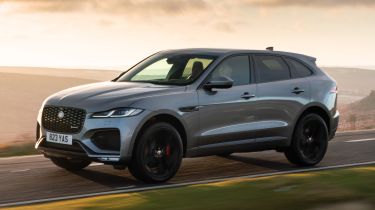Jaguar F-Pace SUV - MPG, running costs & CO2
The plug-in hybrid F-Pace offers a strong electric range; diesel models are relatively economical, too
It’s fair to say that if you’re in the market for a two-tonne SUV, you shouldn’t expect city car-like efficiency, but as long as you avoid the larger engines, Jaguar F-Pace running costs are unlikely to break the bank.
Jaguar F-Pace MPG & CO2
Jaguar discontinued the entry-level D165 2.0-litre diesel model for 2023, so the more-powerful D200 variant is now the cheapest F-Pace you can buy. Thanks to mild-hybrid assistance, this can officially return up to 44.9mpg on the combined WTLP test cycle, though in normal driving you’ll probably see closer to 35mpg. CO2 emissions of 165-170g/km of CO2 are almost irrelevant – all versions cost more than £40,000 and are therefore liable for an additional VED (road tax) surcharge, while company car drivers are likely to take greater interest in the frugal plug-in hybrid.
If diesel is still your fuel of choice, we’d recommend taking a look at the silky-smooth six-cylinder D300, which trades a little fuel economy for extra power. Jaguar claims this version will return up to 37.6mpg and emit 197-199g/km of CO2.
 Top 10 best hybrid SUVs in 2025
Top 10 best hybrid SUVs in 2025
The three petrol models are best-reserved for lower-mileage users; the base P250 will return just 30mpg, while emitting 213-250g/km of CO2. The six-cylinder P400 is thirstier still, offering up to 28.8mpg. Finally, the range-topping SVR model will officially do just 23.2mpg from its monstrous 5.0-litre V8 engine – although expect much lower figures if you plan to make use of all the power that’s on offer.
More reviews
In-depth reviews
Road tests
Used car reviews
As part of the 2023 range update, Jaguar increased the size of the P400e plug-in hybrid’s battery to 19.2kWh (up from 17.1kWh). This means the plug-in F-Pace now offers a pure-electric range of up to 40 miles, which should broaden its appeal. The fact it nudges that 40-mile mark in official tests means it now sits in the 8% Benefit-in-Kind (BiK) tax band for company car drivers – an improvement on the previous 12% rating. Keep the battery charged up and the P400e can return an impressive 176.6mpg and emit just 37g/km of CO2.
Charging the battery to 80% takes just over 1.5 hours using a 7kW wallbox, while 35kW fast charging is also possible, cutting the top-up time to just 30 minutes. The larger BMW X5 xDrive45e has a bigger battery, giving it an EV range of more than 50 miles, but it's also more expensive to buy.
Warranty
Jaguar provides a three-year warranty for the F-Pace, which is about standard for this class of car – although you can extend this at an additional cost. Jaguar customer satisfaction is up, but faults are still common; if you're planning to keep hold of your car for a few years, buying an extended warranty could be a shrewd move.
Servicing
Service intervals are one a year or every 21,000 miles and you can purchase five-year/50,000-mile service plans, priced according to fuel type. Your Jaguar dealer will be able to suggest the plan that best suits your needs.
Insurance
Insurance groups for the Jaguar F-Pace range from 36 for the entry-level diesel to 49 out of 50 for the supercharged V8 SVR model. We always suggest you check for cover before making a purchase decision, especially as the F-Pace is more expensive to insure than rivals.









